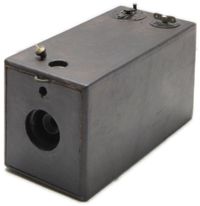A Daylight
The Daylight models are very special cameras because they freed the photographer from the darkroom to change films.
What's so special about that?
The first generation of Kodaks were darkroom loaded cameras. The spools of film had no protection against the light. They had to be loaded into the camera in a dark room. When the photographer was on a day out or on a vacation, he or she had to look for a darkroom when a new film had to be put in the camera. Imagine that you are on the beach and you have taken the last shot on the film. Where could you go to put a new film in the camera?
When Eastman introduced the Daylight Kodaks in December 1891, he tried to improve on this. The films for the Daylight cameras were contained in a box, with a black paper or cloth trailer at the beginning and end of the band of film. Both boxes, feed and take up, were put in the back of the camera.
There are three sizes of Daylight Kodaks: A, B and C. The size A Daylight took pictures of 2 3/4 x 3 1/4 inch (7x8 cm) on a 24 exposure roll of film.
The A Daylight Kodak was intended for snapshooters and was very easy to use. You had to pull the string to cock the shutter, point the camera with the help of a little finder, press the button to take the picture and wind the key to advance the film.
The A Daylight cost $ 8.50, which was one third of the No. 1 Kodak from the same period.
2350 A Daylights were made until the model was discontinued in 1895.
